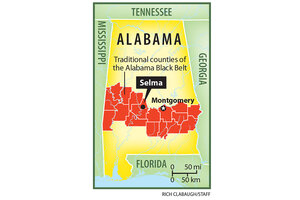A snapshot of Selma, Ala.
True or false: The famed Edmund Pettus Bridge is named after a local general who was also a grand dragon of the Ku Klux Klan.

• Population: 20,756
• Racial mix: 80.3 percent black, 18 percent white, 1.7 percent other
• Median household income: $22,478
• Persons living below poverty level: 41.9 percent
• Unemployment rate: 10.2 percent
• Main industries: educational services (12.1 percent), health care (12 percent), public administration (8.1 percent)
• Largest industrial employer in the area: International Paper Co. (733 employees)
• Nicknames: Queen City of the Black Belt; the state Legislature has also named Selma the Butterfly Capital of Alabama.
• Civil rights history:
On March 7, 1965, some 600 black protesters attempted to cross the Edmund Pettus Bridge. They were met and beaten by 65 Alabama State troopers, 10 Dallas County Sheriff’s deputies, and 15 mounted members of a local posse in what has become known as Bloody Sunday; 56 people were hospitalized.
On March 9, 1965, known as Turnaround Tuesday, Martin Luther King Jr. led 2,500 marchers to the summit of the bridge, where they knelt and prayed.
On March 21, 1965, King led 8,000 marchers – protected by 2,000 National Guard members – on a five-day, 54-mile march to Montgomery, Ala. About 25,000 people were at the capitol to hear King speak.
• Edmund Pettus Bridge: built in 1940; named after Edmund Winston Pettus, a Civil War general, US senator, and grand dragon of the Alabama Ku Klux Klan
Sources: US Census Bureau, Alabama Department of Labor, Selma & Dallas County Economic Development Authority, Concordia College, city websites


